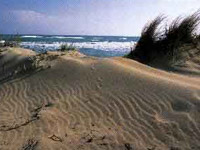
Capo Feto - Mazara del Vallo
In the most southerly part of the province of Trapani, west of Mazara del Vallo, there is one of the last wet areas of Sicily, a place among the most important in Europe that deserves a special protection.
The Capo Feto Protected Area cover 453 hectares of sand dunes and small bodies of water. There the ground forms a deep hollow, separated from the sea by a tombolo, that is almost submerged in winter and drier during the summer. From 1999 to 2002 the marshes of Capo Feto were included in a project of the European Community, Life-Nature, for the reintroduction of species disappeared in their areas of origin.
Before the area had been savagely exploited by people who did not understood the importance of that ecosystem, and was about to destroy it. In 2006 the area was marked by underwater archaeological excavations that brought to light the relicts of some boats probably dated back to 4th - 3rd century BC.
How to get there
There are no indications to go there. You have to go along unmade roads after having turned right into the SS 115 (Petrosino)
Administrative body
Regional Province of Trapani
Via Vito Carrera, 23 – 91100 Trapani
Tel: 0923 87367 FLORA & FAUNA Flora
The sea – Capo Feto is characterized by the presence of the Posidonia oceanica, an endemic Mediterranean plant that evolved passing from the dry land to the marine environment. It has roots, stem, leaves and reproduce by the flowers unlike common seaweeds. In winter the dry leaves break off the stem and accumulate in the coast where they form those very peculiar piles, even very big, becoming a natural barrier. This barrier closes the expanse of water closer to the shore that becomes a small lagoon. There you can find a lot of small spheres typical of the Posidonia that originate from the dry leaves through the action of the sea and wind. If you are on a beach full of those small black spheres, it means that a colony of Posidonia is very near. The life and the distribution of this type of vegetation is closely connected to the morphology and salinity of the soil. The Posidonia adapts very well to sandy or muddy-clayey soil with a very high rate of salinity and dry in summer. The Posidonia is very important for these areas: it protects the sandy soil from erosion and gives shelter to many marine organisms.
The coast – As far as the coast is concerned, the main species that deserve to be mentioned are: the Reed, typical of marshy areas, the Sedge, the Glasswort, a perennial plant with erect stem, the Inula with yellow flowers, the Sea rocket that form rounded piles in the shores, the Barilla plant, a small plant with red leaves and red stem, the Prickly Saltwort, similar to the previous one but with thorny endings, the Suaeda maritima whose branches are directed upwards, the Sea daffodil with white umbrella-shaped flowers, the Lotus cytisoides with yellow flowers, the Squill, herbaceous plant with large leaves, the Barbosa with beautiful soft-coloured flowers, the Yellow Ophrys, an orchid with yellow and red petals, the Bumblebee orchid with small and green flowers, the Sea cudweed with dentated leaves, the Prickly samphire with white flowers, the Yellow hornpoppy with yellow petals and finally the Limonium, endemic in its varieties Limonium vulgare subsp. serotinus, Limonium virgatum subsp. virgatum, Limonium helophilum. Fauna – Migratory birds usually like areas like this, wet and with many bodies of water, where they can feed and rest.
The Capo Feto Reserve is on the route of all those species that move between Africa and the Central Europe. There you can find many anseriformes, charadriiformes, ciconiiformes and pelicaniformes. There are a lot of aquatic species like the Garganey, the Wild duck and the Shoveller. You may also find the Kentish plover, a small shore bird, the Gallinule with dark feathering and the very long legs of the Grey heron and of the Stilt-bird. In the sea – The fauna of the sea in front of the protected area is the typical one you can find in a colony of Posidonia. Since more offshore those colonies alternate with rocks, you can find also some species typical of hard seabeds. Among the Posidonia one can admire shoals of Salpas with green livery striped with gold, Scorpion fishes, very particular dark ochre fishes, and very big Octopus. In deeper water there are Grey mullets and Basses. There you can see also the Pond turtle.
|

